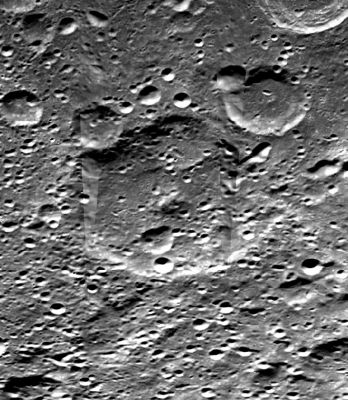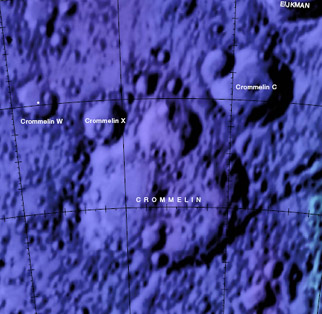Difference between revisions of "Crommelin"
(Created page with "<div id="content_view" class="wiki" style="display: block"> =Crommelin= {| class="wiki_table" | Lat: 68.1°S, Long: 146.9°W, Diam: 94 km, Depth: km, Rükl: ''(farside)''<b...") |
|||
| Line 9: | Line 9: | ||
[[Image:crommelin-color.jpg|crommelin-color.jpg]]<br /> | [[Image:crommelin-color.jpg|crommelin-color.jpg]]<br /> | ||
|} | |} | ||
| − | '''Left:''' [http://www.mapaplanet.org/explorer-bin/explorer.cgi?map=Moon&layers=moon_clementine_base_v2&west=193.5&south=-81.75&east=240.5&north=-58.25¢er=217¢er_lat=0&defaultcenter=on&grid=none&stretch=auto&resamp_method=nearest_neighbor&projection=SIMP&r=1&g=1&b=1&advoption=YES&info=NO&resolution=15.3191489361702&lines=360&samples=720&scale=1.97944&imageTopX=-711609.0134382248&imageTopY=-1766651.0277986526&box=no&x=285&y=144 Clementine] image from [http://www.mapaplanet.org Map-A-Planet]. '''Right:''' [http://planetarynames.wr.usgs.gov/images/Lunar/lac_142.pdf Color-coded topography LAC 142] image from [ | + | '''Left:''' [http://www.mapaplanet.org/explorer-bin/explorer.cgi?map=Moon&layers=moon_clementine_base_v2&west=193.5&south=-81.75&east=240.5&north=-58.25¢er=217¢er_lat=0&defaultcenter=on&grid=none&stretch=auto&resamp_method=nearest_neighbor&projection=SIMP&r=1&g=1&b=1&advoption=YES&info=NO&resolution=15.3191489361702&lines=360&samples=720&scale=1.97944&imageTopX=-711609.0134382248&imageTopY=-1766651.0277986526&box=no&x=285&y=144 Clementine] image from [http://www.mapaplanet.org Map-A-Planet]. '''Right:''' [http://planetarynames.wr.usgs.gov/images/Lunar/lac_142.pdf Color-coded topography LAC 142] image from [[USGS%20Digital%20Atlas|USGS Digital Atlas]].<div id="toc"> |
=Table of Contents= | =Table of Contents= | ||
<div style="margin-left: 1em">[#Crommelin Crommelin]</div><div style="margin-left: 2em">[#Crommelin-Images Images]</div><div style="margin-left: 2em">[#Crommelin-Maps Maps]</div><div style="margin-left: 2em">[#Crommelin-Description Description]</div><div style="margin-left: 2em">[#Crommelin-Description: Wikipedia Description: Wikipedia]</div><div style="margin-left: 2em">[#Crommelin-Additional Information Additional Information]</div><div style="margin-left: 2em">[#Crommelin-Nomenclature Nomenclature]</div><div style="margin-left: 2em">[#Crommelin-LPOD Articles LPOD Articles]</div><div style="margin-left: 2em">[#Crommelin-Bibliography Bibliography]</div></div><br /> <br /> | <div style="margin-left: 1em">[#Crommelin Crommelin]</div><div style="margin-left: 2em">[#Crommelin-Images Images]</div><div style="margin-left: 2em">[#Crommelin-Maps Maps]</div><div style="margin-left: 2em">[#Crommelin-Description Description]</div><div style="margin-left: 2em">[#Crommelin-Description: Wikipedia Description: Wikipedia]</div><div style="margin-left: 2em">[#Crommelin-Additional Information Additional Information]</div><div style="margin-left: 2em">[#Crommelin-Nomenclature Nomenclature]</div><div style="margin-left: 2em">[#Crommelin-LPOD Articles LPOD Articles]</div><div style="margin-left: 2em">[#Crommelin-Bibliography Bibliography]</div></div><br /> <br /> | ||
| Line 15: | Line 15: | ||
[http://www.lpod.org/coppermine/thumbnails.php?album=search&type=full&search=Crommelin LPOD Photo Gallery] [http://www.lpi.usra.edu/resources/lunar_orbiter/bin/srch_nam.shtml?Crommelin%7C0 Lunar Orbiter Images] [http://www.lpi.usra.edu/resources/apollo/search/feature/?feature=Crommelin Apollo Images]<br /> <br /> | [http://www.lpod.org/coppermine/thumbnails.php?album=search&type=full&search=Crommelin LPOD Photo Gallery] [http://www.lpi.usra.edu/resources/lunar_orbiter/bin/srch_nam.shtml?Crommelin%7C0 Lunar Orbiter Images] [http://www.lpi.usra.edu/resources/apollo/search/feature/?feature=Crommelin Apollo Images]<br /> <br /> | ||
==Maps== | ==Maps== | ||
| − | ''([ | + | ''([[LAC%20zone|LAC zone]] 142B4)'' [http://planetarynames.wr.usgs.gov/images/Lunar/lac_142.pdf USGS Digital Atlas PDF]<br /> <br /> |
==Description== | ==Description== | ||
| − | '''Crommelin''' lies some 800 kilometres south-east from the main central region of the [ | + | '''Crommelin''' lies some 800 kilometres south-east from the main central region of the [[South%20Pole-Aitken%20Basin|South-Pole Aitken Basin]] -- a 2500 kilometre-wide basin of the [[Stratigraphy|pre-Nectarian]] period (~ 4.6 to 3.92 bn years). The crater is barely perceptible amongst an amalgamation of impact craters of all sizes (most particularly of small craterlets) that have shapened nearly most of '''Crommelin's''' outer ramparts, its well-worn rim, and interior floor. Several of the major, younger impact events on the outer northern sectors of the crater, for example, '''Crommelin C''' to its north-east and '''Crommelin X''' to its north-west (and the smalller craters in between) have imparted material onto the floor of '''Crommelin'''. It looks like this material, too, has subsequently been covered over by later material from another series of impact events whose craters (craterlets) dominate the whole of the floor's history; making it hard to ditinguish features like the collapsed wall south-east of '''Crommelin X''', the southern part of the large crater within the northern sector of '''Crommelin''', and, of course, the central peak now barely recognisable. But where have all these young, destruct-like craters (craterlets) come from? Looking at both the inside and outside regions of '''Crommelin''' as a whole, perhaps we're looking at secondaries and tertiaries produced from the main impact-basin events nearby, like those, for example, of the [[Mendel-Rydberg%20Basin|Mendel-Rydberg Basin]] some 700 km east-north-east of the crater, or the [[Mare%20Orientale|Orientale Basin]] some 2000 km away in a north-easterly direction? Probably, a combination of both (and others in the region) is responsible, however, from the freshness of most of the craters (craterlets) seen in the region, not to mention the radial, chain direction of some, the most likely candidate is '''Orientale'''. <span class="membersnap">- [http://www.wikispaces.com/user/view/JohnMoore2 [[Image:JohnMoore2-lg.jpg|16px|JohnMoore2]]] [http://www.wikispaces.com/user/view/JohnMoore2 JohnMoore2]</span><br /> <br /> |
==Description: Wikipedia== | ==Description: Wikipedia== | ||
[http://en.wikipedia.org/wiki/Crommelin_(crater) Crommelin]<br /> <br /> | [http://en.wikipedia.org/wiki/Crommelin_(crater) Crommelin]<br /> <br /> | ||
Revision as of 15:44, 15 April 2018
Contents
Crommelin
| Lat: 68.1°S, Long: 146.9°W, Diam: 94 km, Depth: km, Rükl: (farside) | |
Table of Contents
Images
LPOD Photo Gallery Lunar Orbiter Images Apollo Images
Maps
(LAC zone 142B4) USGS Digital Atlas PDF
Description
Crommelin lies some 800 kilometres south-east from the main central region of the South-Pole Aitken Basin -- a 2500 kilometre-wide basin of the pre-Nectarian period (~ 4.6 to 3.92 bn years). The crater is barely perceptible amongst an amalgamation of impact craters of all sizes (most particularly of small craterlets) that have shapened nearly most of Crommelin's outer ramparts, its well-worn rim, and interior floor. Several of the major, younger impact events on the outer northern sectors of the crater, for example, Crommelin C to its north-east and Crommelin X to its north-west (and the smalller craters in between) have imparted material onto the floor of Crommelin. It looks like this material, too, has subsequently been covered over by later material from another series of impact events whose craters (craterlets) dominate the whole of the floor's history; making it hard to ditinguish features like the collapsed wall south-east of Crommelin X, the southern part of the large crater within the northern sector of Crommelin, and, of course, the central peak now barely recognisable. But where have all these young, destruct-like craters (craterlets) come from? Looking at both the inside and outside regions of Crommelin as a whole, perhaps we're looking at secondaries and tertiaries produced from the main impact-basin events nearby, like those, for example, of the Mendel-Rydberg Basin some 700 km east-north-east of the crater, or the Orientale Basin some 2000 km away in a north-easterly direction? Probably, a combination of both (and others in the region) is responsible, however, from the freshness of most of the craters (craterlets) seen in the region, not to mention the radial, chain direction of some, the most likely candidate is Orientale. - JohnMoore2 JohnMoore2
Description: Wikipedia
Additional Information
Nomenclature
Andrew Claude De La Cherois; British astronomer (1865-1939).
LPOD Articles
Bibliography
This page has been edited 1 times. The last modification was made by - tychocrater tychocrater on Jun 13, 2009 3:24 pm - afx3u2

